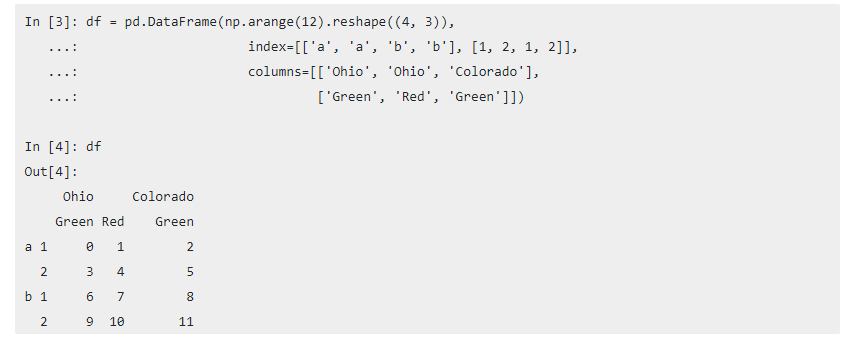Hierarchical index
MultiIndex is a hierarchical index object
tup = [('beijing',2000),('beijing',2019),
('shanghai',2000),('shanghai',2019),
('guangzhou',2000),('guangzhou',2019)]
values = [10000,100000,6000,60000,4000,40000]
index = pd.MultiIndex.from_tuples(tup) # Generating MultiIndex with Tuples
sss = pd.Series(values, index=index) # Provide a MultiIndex as an index
>>>
>beijing 2000 10000
2019 100000
shanghai 2000 6000
2019 60000
guangzhou 2000 4000
2019 40000
More ways to create MultiIndex include:
From the list: pd.MultiIndex.from_arrays([['a','a','b','b'],[1,2,1,2])
From tuples: pd.MultiIndex.from_tuples([('a',1),('a',2),('b',1),('b',2)])
Cartesian product: pd.MultiIndex.from_product([['a','b'],[1,2])
Direct construction: pd.MultiIndex (levels=['a','b'], [1,2]], labels=[[0,0,1,1], [0,1,0,1])
#=========================
Hierarchical indexing is very important in reshaping data and array perspective tables. For example, we can use the unstack method to rearrange data in the DataFrame, that is, to expand:
s.unstack() 1 2 3 a 0.283490 0.295529 0.277676 b 0.487573 NaN 0.091161 c 0.285157 -0.806851 NaN d NaN -0.287969 -0.696511 #-------------------------------------------------------------------------------------- s.unstack().stack() # Inverse stack a 1 0.283490 2 0.295529 3 0.277676 b 1 0.487573 3 0.091161 c 1 0.285157 2 -0.806851 d 2 -0.287969 3 -0.696511
#==================
For DataFrame objects, each axis can be hierarchically indexed, providing a multidimensional array for index or columns to hierarchize:
Advanced Hierarchical Index
DataFrame object
sort_index(level=1) means to sort the indexes at the second level.
swaplevel(0, 1) means to exchange row indexes at Layer 0 and Layer 1.
Original:
state Ohio Colorado
color Green Red Green
key1 key2
a 1 0 1 2
b 1 6 7 8
a 2 3 4 5
b 2 9 10 11
#--------------------------------------
df.swaplevel(0, 1).sort_index(level=0)
state Ohio Colorado
color Green Red Green
key2 key1
1 a 0 1 2
b 6 7 8
2 a 3 4 5
b 9 10 11
Indexing with columns in the DataFrame
df= pd.DataFrame({'a': range(7), 'b': range(7, 0, -1),
'c': ['one', 'one', 'one', 'two', 'two', 'two', 'two'],
'd': [0, 1, 2, 0, 1, 2, 3]})
df>>>
a b c d
0 0 7 one 0
1 1 6 one 1
2 2 5 one 2
3 3 4 two 0
4 4 3 two 1
5 5 2 two 2
6 6 1 two 3
set_index(['c','d']) converts C and D columns into hierarchical row indexes
drop=False retains the original column data
reset_index is the reverse operation of set_index
df2 = df.set_index(['c','d'])
df2
a b
c d
one 0 0 7
1 1 6
2 2 5
two 0 3 4
1 4 3
2 5 2
3 6 1
#--------------------------------------
df.set_index(['c','d'],drop=False)
a b c d
c d
one 0 0 7 one 0
1 1 6 one 1
2 2 5 one 2
two 0 3 4 two 0
1 4 3 two 1
2 5 2 two 2
3 6 1 two 3
#------------------------------------
df2.reset_index()
c d a b
0 one 0 0 7
1 one 1 1 6
2 one 2 2 5
3 two 0 3 4
4 two 1 4 3
5 two 2 5 2
6 two 3 6 1
DataFrame Index Slice
If MultiIndex is not an ordered index, most slicing operations fail! At this point, you can use the sort_index method described earlier to sort the order first.
In [19]: df = pd.DataFrame(np.arange(12).reshape((4, 3)),
...: index=[['a', 'a', 'b', 'b'], [1, 2, 1, 2]],
...: columns=[['Ohio', 'Ohio', 'Colorado'],
...: ['Green', 'Red', 'Green']])
...:
In [20]: df
Out[20]:
Ohio Colorado
Green Red Green
a 1 0 1 2
2 3 4 5
b 1 6 7 8
2 9 10 11
In [23]: df['Ohio','Colorado'] # You can't do this because the column index is hierarchical
KeyError Traceback (most recent call last)
---------------------------------------------------------------------------
In [24]: df[['Ohio','Colorado']] # This way
Out[24]:
Ohio Colorado
Green Red Green
a 1 0 1 2
2 3 4 5
b 1 6 7 8
2 9 10 11
#----------------------------------------
In [25]: df['Ohio','Green'] # Each layer provides a parameter
Out[25]:
a 1 0
2 3
b 1 6
2 9
Name: (Ohio, Green), dtype: int32
#----------------------------------------
In [26]: df.iloc[:2,:2] # Implicit indexing
Out[26]:
Ohio
Green Red
a 1 0 1
2 3 4
#----------------------------------------
In [28]: df.loc[:,('Ohio','Red')] # This is more difficult to understand.
Out[28]:
a 1 1
2 4
b 1 7
2 10
Name: (Ohio, Red), dtype: int32